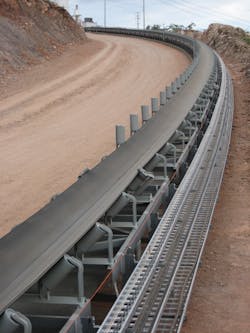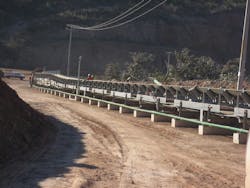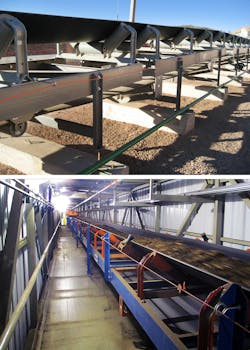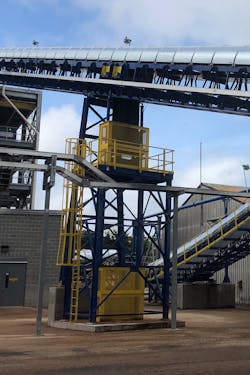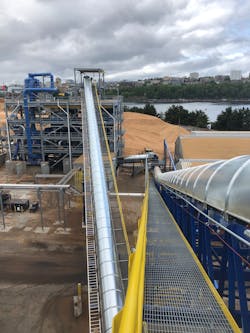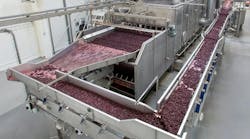Troughed belt conveyors are the backbone of industrial process settings, conveying materials at every distance, from a few feet to a few miles. Confusion often arises, however, between what many call conventional (or plant) conveyors and overland conveyors.
Despite the difference in nomenclature, these two conveyor types are largely the same, with only a few differences when the conveyor will be required to traverse long distances.
Though no formal definition exists, an overland conveyor is generally considered to be any conveyor intended to traverse some distance of terrain, from several hundred feet up to several miles, while a plant conveyor is intended to carry material shorter distances (less than several hundred feet), though there is some overlap in between.
Overland conveyors are typically sized to offer a continuous means of transport that can replace discrete truck haulage between points. These conveyors are often faster and use wider belts than plant conveyors to achieve capacities that are competitive with truck haulage.
Energy generation
One of the primary differences between a plant conveyor and an overland conveyor is that the long distances typical of overland settings can provide the opportunity for energy generation where a section of the conveyor traverses a decline. In an overland setting, the kinetic energy of material traveling downhill on a conveyor can be captured and converted into electricity using inverter-duty motors paired with variable frequency drives (VFDs). This electricity can then be sold back to the grid to supplement energy costs.
In non-overland settings, conveyors with a decline are rarely long enough or steep enough to generate enough electricity to offset their inherent resistances.
Construction
A few key design differences between plant and overland conveyors help each better suit its intended application.
Foundation requirements. Plant conveyors tend to be mounted on poured cement foundations using anchor bolts. The concrete foundation is poured based on the unit’s expected load. This type of foundation would not only be extremely costly in an overland setting but would also be impractical considering the changes in terrain.
Instead, overland conveyor manufacturers typically use concrete sleepers or simple Sonotube-type foundations placed throughout the landscape to support the unit. The sleepers are placed as needed and buried to support the unit, allowing the installer to make height adjustments along the terrain without requiring the excessive earthwork needed for a concrete pad. This also can help installers avoid challenging soil types where possible.
The shorter distances and flat grades associated with plant conveyors eliminate the need to accommodate changes in grade. If necessary, the manufacturer can simply raise the conveyor above any undulations using A-frame supports. While A-frame supports can increase capital cost, it is easier and more efficient to move material along a straight path for shorter distances.
Frames. Plant conveyors may utilize channel or truss frames, depending on a variety of factors such as the length of spans between support points, walkway layout, total weight of material, use of drip or cable trays, covers, and even environmental considerations such as seismic, wind, snow, and ice loads.
Overland conveyors also rely on both frame types, also taking the aforementioned factors into account. However, because they have better control over where their support points will be located, they tend to favor channel frames, incorporating truss frames only when terrain requires it, such as when crossing a deep ravine or negotiating challenging grade changes.
In the case of overland conveyors, the frame may also be divided into sections to better navigate uneven terrain and eliminate the need for thermal expansion joints. In contrast, a conventional conveyor typically employs one solid frame for the length of the conveyor.
Takeups. Takeup systems, which maintain proper belt tension on a conveyor, also differ according to the lengths the conveyors span. Conventional conveyors typically employ gravity or screw takeups. In cases where the length dictates a gravity-style takeup but there is not enough clearance under the conveyor, a horizontal takeup may be used.
Drive systems. Due to their short distances, plant conveyors can almost always rely on a single drive system per conveyor. In an overland setting, however, one drive may not be enough, depending on the length.
Multiple drives, as well as the use of “boosters” (tripper stations along the length of the conveyor) may be employed to reduce belt tensions and to help negotiate varying terrain along the conveyor path.
Carrying belts. The belt itself may also differ depending on whether the conveyor will be used in a plant or overland setting. In a plant or other short-distance setting, conveyor manufacturers typically employ a rubber belt reinforced internally with fabric “plies.”
In an overland setting, fabric belts are used on shorter conveyors, but the extensive length of some belts often requires more overall tension capacity, so conveyor manufacturers instead employ steel cord belts.
As mentioned, overland conveyor manufacturers also frequently utilize a wider belt to further increase capacity and improve hauling efficiency, making the conveyors competitive with truck haulage.
Manufacturers must also take care in negotiating horizontal, vertical, and compound curves in an overland setting, carefully managing belt tension to prevent buckling or uplift of the belt. In some cases, overland conveyors may be split up into multiple conveyors, referred to as “flights,” to better negotiate challenging terrain.
Plant conveyors do not use horizontal curves because of their short distances, instead always keeping the path of travel in a straight line and feeding the conveyor at a skew when necessary. While conventional conveyor manufacturers do not need to manage belt tension in this aspect, they do have to manage belt tension to contend with vertical curves (among other factors).
Idlers and pulleys. The heavier belts and higher speeds of overland conveyors often require idlers that have larger diameters and that are more heavily constructed.
In conventional heavy-duty applications, CEMA-C idlers are most common, with CEMA-D and E sometimes chosen for more demanding applications. In overland applications, manufacturers tend to use CEMA-D, E, or even F-style idlers.
Pulleys must also be significantly larger in diameter when using the heavier belts that are typical in overland conveyors, as the thicker carcasses or heavy steel cords should not be subjected to sharp bends.
Maintenance
Since these two types of belt conveyors rely on the same basic build, their maintenance requirements are identical, with one exception: the long distance associated with an overland conveyor means that the unit cannot be monitored at a glance like a conventional conveyor can. Operators or maintenance personnel must routinely walk the conveyor line to inspect for abnormalities, such as sounds that could indicate a worn idler or bearing.
Pipe conveying
Conveyors traveling long distances also have the potential to be designed for “pipe conveying,” which is where the conveyor belt edges curl in at the top, essentially forming a “pipe” with the material enclosed inside. While this requires a special type of belting, as well as additional idlers to maintain the pipe formation, it is useful for protecting the conveyed material from the elements. A pipe conveyor also allows for a tighter radius on horizontal curves. Pipe conveying is impractical in conventional conveyor settings, due to the length of belt required for curling and uncurling. Instead, conventional conveyors employ weather covers.
[BIOS]
For more information on plant conveyors, contact Dan Baxter, material handling sales at FEECO International. For information on overland conveyors, contact Marc Dos Santos, vice president and owner at Dos Santos International.
FEECO International
www.feeco.com
Dos Santos International
www.dossantosintl.com
